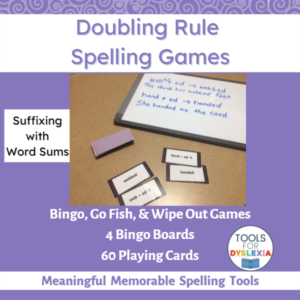9 Games To Practice the 3 Suffixing Rules
My students and I enjoy playing games–games to practice reading, spelling, suffixing rules, etc. When either reading or spelling are difficult, making the practice a game seems less tiresome. Spelling as we play tic tac toe or Connect 4 doesn’t feel like such a long haul.
What Are the Suffixing Rules?
Suffixing is a verb that means adding a suffix to the end of a base or adding a suffix to a previous suffix. We have three rules for the spelling changes that happen when we add suffixes.
Remembering the three suffixing rules and applying them correctly takes some practice. I created three new games for each of the three suffixing rules.
Doubling a word’s final consonant before adding a vowel suffix seems to be one that students struggle to apply. What’s a vowel suffix? One that starts with a vowel letter. In a one-syllable word, all we need to notice is that we are adding the vowel suffix to a base ending with a single vowel letter and a single consonant letter. If that’s the case, double the final consonant letter. However, we never double X.

The other two suffixing rules are replacing (dropping) a final E and changing Y to I. When we add a vowel suffix to a base that ends with a single, unpronounced <e>, like in bake/ + er –> baker, we drop (replace) the final <e> with the vowel suffix. The final <e> is also replaced when a suffix like <-ate, -ine, -le> and lots of others have a vowel suffix added to it.
Changing Y to I is done when the base ends with a single letter <y> and a vowel suffix OR a consonant suffix is added. Notice that it’s not just when a vowel suffix is added. Although there are times we won’t change <y> to <i>. Generally, we do not want a double <i> so if we’re adding the <-ing> suffix to the base, baby, we won’t change the <y>. Suffixing does not happen when we’re combining two words to create a compound word. Why not? The second word isn’t a suffix; it’s a base just like the first one. Everyone–no suffixing. Anybody–no suffixing. Changing Y to I also applies to a suffix added to a previous suffix such as: live + ly + er –> livelier
What’s in the Suffixing Games?
Each set of games includes Bingo, Go Fish, and Wipe Out. We play Wipe Out by taking some of the word sum cards and writing WIPE OUT on several of the blank game cards to mix into the deck of word sum cards. Players take turns saying the word sum and finishing it aloud or on paper–using the suffixing rules they are practicing. They can keep doing more word sums and keeping the cards or they can stop to avoid getting a WIPE OUT card, which wipes out the cards they had earned on that turn.
The game cards are pairs of word sums and complete words. Both are used for Go Fish. We use just the word sum cards for Bingo and Wipe Out. Word sums are such a great visual for students to see what is happening as we add prefixes and suffixes and apply suffixing rules
“Play is our brain’s favorite way of learning.” Diane Ackerman
The great thing about these games, besides the fun practice, is that anyone can win. Kids love to beat me, and I love for the kids to beat me while they’re learning! They win and I win!
Let’s Play!



